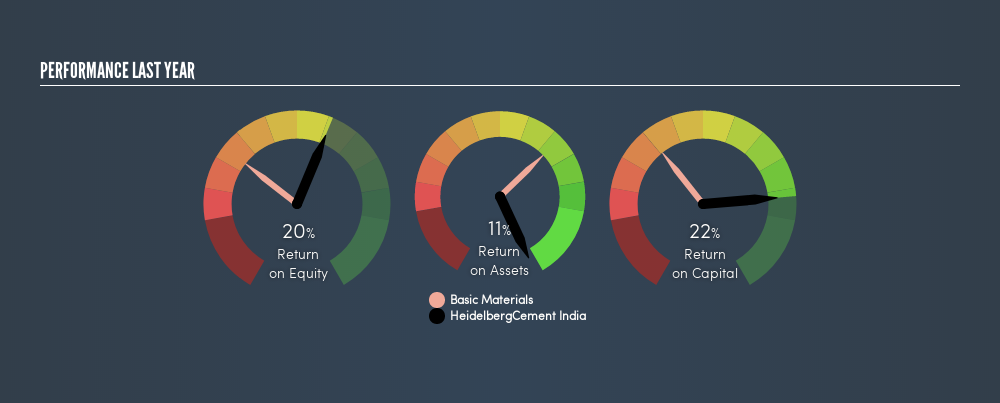- India
- /
- Basic Materials
- /
- NSEI:HEIDELBERG
HeidelbergCement India Limited (NSE:HEIDELBERG) Is Employing Capital Very Effectively

Today we are going to look at HeidelbergCement India Limited (NSE:HEIDELBERG) to see whether it might be an attractive investment prospect. In particular, we'll consider its Return On Capital Employed (ROCE), as that can give us insight into how profitably the company is able to employ capital in its business.
Firstly, we'll go over how we calculate ROCE. Then we'll compare its ROCE to similar companies. Finally, we'll look at how its current liabilities affect its ROCE.
Understanding Return On Capital Employed (ROCE)
ROCE measures the amount of pre-tax profits a company can generate from the capital employed in its business. All else being equal, a better business will have a higher ROCE. In brief, it is a useful tool, but it is not without drawbacks. Renowned investment researcher Michael Mauboussin has suggested that a high ROCE can indicate that 'one dollar invested in the company generates value of more than one dollar'.
How Do You Calculate Return On Capital Employed?
Analysts use this formula to calculate return on capital employed:
Return on Capital Employed = Earnings Before Interest and Tax (EBIT) ÷ (Total Assets - Current Liabilities)
Or for HeidelbergCement India:
0.22 = ₹3.8b ÷ (₹25b - ₹7.5b) (Based on the trailing twelve months to December 2018.)
So, HeidelbergCement India has an ROCE of 22%.
See our latest analysis for HeidelbergCement India
Is HeidelbergCement India's ROCE Good?
ROCE can be useful when making comparisons, such as between similar companies. Using our data, we find that HeidelbergCement India's ROCE is meaningfully better than the 9.8% average in the Basic Materials industry. We would consider this a positive, as it suggests it is using capital more effectively than other similar companies. Independently of how HeidelbergCement India compares to its industry, its ROCE in absolute terms appears decent, and the company may be worthy of closer investigation.
In our analysis, HeidelbergCement India's ROCE appears to be 22%, compared to 3 years ago, when its ROCE was 7.4%. This makes us wonder if the company is improving.

When considering this metric, keep in mind that it is backwards looking, and not necessarily predictive. ROCE can be misleading for companies in cyclical industries, with returns looking impressive during the boom times, but very weak during the busts. ROCE is, after all, simply a snap shot of a single year. Future performance is what matters, and you can see analyst predictions in our freereport on analyst forecasts for the company.
Do HeidelbergCement India's Current Liabilities Skew Its ROCE?
Liabilities, such as supplier bills and bank overdrafts, are referred to as current liabilities if they need to be paid within 12 months. Due to the way ROCE is calculated, a high level of current liabilities makes a company look as though it has less capital employed, and thus can (sometimes unfairly) boost the ROCE. To check the impact of this, we calculate if a company has high current liabilities relative to its total assets.
HeidelbergCement India has total liabilities of ₹7.5b and total assets of ₹25b. As a result, its current liabilities are equal to approximately 30% of its total assets. With this level of current liabilities, HeidelbergCement India's ROCE is boosted somewhat.
What We Can Learn From HeidelbergCement India's ROCE
While its ROCE looks good, it's worth remembering that the current liabilities are making the business look better. There might be better investments than HeidelbergCement India out there, but you will have to work hard to find them . These promising businesses with rapidly growing earnings might be right up your alley.
I will like HeidelbergCement India better if I see some big insider buys. While we wait, check out this freelist of growing companies with considerable, recent, insider buying.
We aim to bring you long-term focused research analysis driven by fundamental data. Note that our analysis may not factor in the latest price-sensitive company announcements or qualitative material.
If you spot an error that warrants correction, please contact the editor at editorial-team@simplywallst.com. This article by Simply Wall St is general in nature. It does not constitute a recommendation to buy or sell any stock, and does not take account of your objectives, or your financial situation. Simply Wall St has no position in the stocks mentioned. Thank you for reading.
About NSEI:HEIDELBERG
HeidelbergCement India
Engages in the manufacture and sale of cement in India.
Flawless balance sheet with proven track record.


